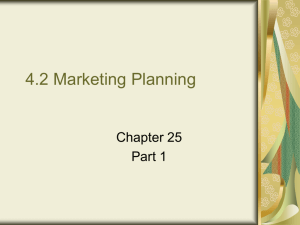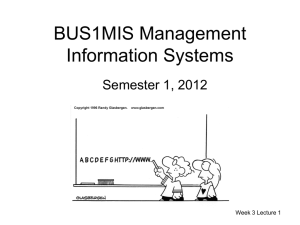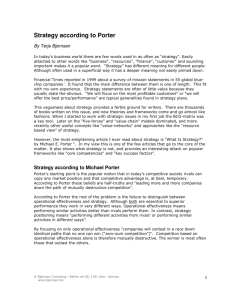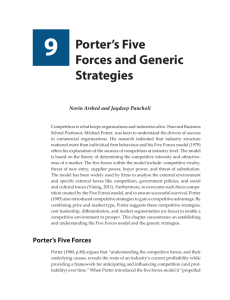on Setting Corporate Aims and Objectives
advertisement
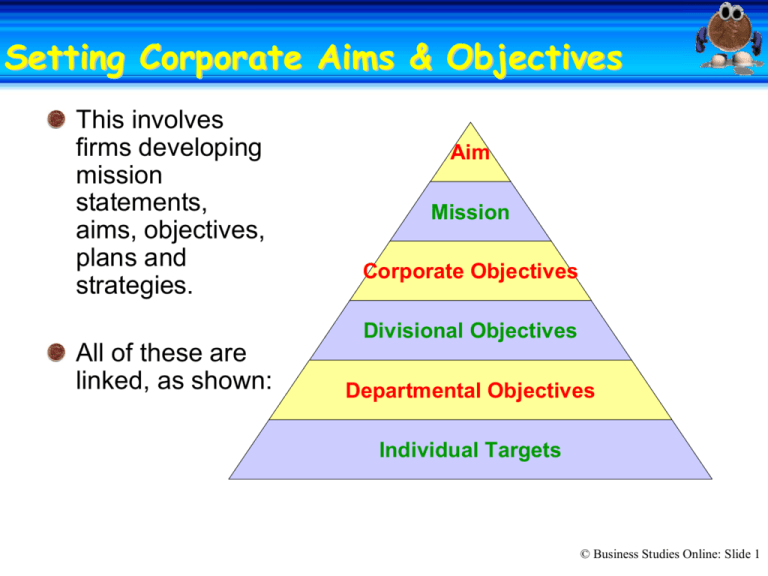
Setting Corporate Aims & Objectives Objectives This involves firms developing mission statements, aims, objectives, plans and strategies. Aim Mission Corporate Objectives Divisional Objectives All of these are linked, as shown: Departmental Objectives Individual Targets © Business Studies Online: Slide 1 Corporate Aims Aims Corporate aims express the long­term intention of an organisation to develop in a certain way. The idea behind setting aims is that: everyone in the business has a clear focus of the direction that it is going in. a business can see how much it has achieved after a given time They provide a framework within which business strategies can be drawn up © Business Studies Online: Slide 2 From Aim To Mission Mission Having set long­term aims a business will need to communicate them to the stakeholders. This is done through a mission statement Mission statements will outline the overall reasons for the firm’s existence Examples would be: “…to ensure our products are within an arm’s length of desire” “…to be the world's best international home improvement retailer, using its scale and diversity to deliver sustainable growth and improved returns for shareholders ” © Business Studies Online: Slide 3 Are Mission Statements Worthwhile? Worthwhile? Mission statements are something relatively new, and some believe they are a management “fad” But are they worth having? YES All stakeholders will know the central aim of the business Motivates employees Gives a sense of direction NO They are vague, and say little about the business Simply a PR exercise Impossible to disagree with them © Business Studies Online: Slide 4 Missions, Goals & Objectives Objectives These terms are often confused The differences are as follows: Term Definition Example MISSION Overall Purpose To be the best known name in confectionery GOAL General Statement To be the market leader in confectionery sales Quantifiable Statement OBJECTIVE of the goal To increase sales by 10% per year © Business Studies Online: Slide 5 Corporate Objectives Objectives Aims and mission statements are long­term, and therefore lack the detail for day­to­day decisions This detail will be given in the firm’s objectives, which should set measurable targets Many business set 2 types of objectives: Objectives Strategic Tactical These are often long-term, ie should we enter a new market These are often shortterm, ie what should the specifications of a new product be? © Business Studies Online: Slide 6 Possible Objectives Objectives The objectives that a firm adopts may include: Profit Profit Maximisation Maximisation To Maximise To Maximise Returns Returns Growth Growth To To Diversify Diversify To Focus On To Focus On Strengths Strengths To Increase To Increase Market Share Market Share © Business Studies Online: Slide 7 What Determines Objectives? Objectives? Corporate Culture This relates to the manner in which a firm is run Size & Legal Form of the Business Small firms will have different objectives to large firms Private sector firms will have different objectives to public sector ones Age of the Business New businesses are likely to want to survive Older firms will want to make a profit © Business Studies Online: Slide 8 Conflicts In Objectives Objectives Different stakeholders will have different objectives: STAKEHOLDER POSSIBLE OBJECTIVE Shareholders High dividends Managers Promotion Employees Higher Wages Customers Low Prices Society More Jobs Government High Tax Revenues Creditors Healthy Cash Flow Suppliers Increased Sales The objectives of the most important stakeholders are likely to be given first priority © Business Studies Online: Slide 9 Divisional, Departmental & Individual Objectives Objectives Once a firm has set it’s corporate objectives, they may break them down into specific targets for: Each division or department Individuals within each department This process is called Management by Objectives (MBO) © Business Studies Online: Slide 10 Establishing A Corporate Plan Plan Having established their objectives a business will draw up a plan for the medium­long term. This will set out how they are going to achieve their objectives. This plan will outline the strategies that the firm will adopt. © Business Studies Online: Slide 11 Types of Plans Plans There are 4 types of plans Operational Where the business tries to increase the efficiency of the business E.g. change quality control system Corporate Aimed at long­term position E.g. aim to double in size over the next 10 years through mergers/acquisitions Generic Used to gain a competitive advantage E.g. Centrica sold off One­Tel in 2005 to concentrate on its energy business Global Businesses may set up factories in other countries E.g. Dyson moving production to Malaysia © Business Studies Online: Slide 12 Achieving Strategic Development Development Internal Development Where the business grows by increasing sales and profit over time. This is the least risky strategy, but may take time Takeovers, Mergers & Acquisitions Allows quick growth, but can present problems, i.e. staffing, diseconomies of scale Collaborative Strategies and Alliances Where a business will work together with other companies to create joint ventures. Often referred to as SYNERGY © Business Studies Online: Slide 13 Forming A Strategy Strategy Michael Porter’s Five Forces model is often used to do this. Porter believed that firms should consider: Threat of Threat of Competition Competition Buyers Buyers Power Power Suppliers Suppliers Power Power Threat of Threat of Substitutes Substitutes Degree of Degree of Rivalry Rivalry © Business Studies Online: Slide 14 Porter‛s 5 Forces (1) (1) Porter made recommendations to deal with each type of threat: 1)Threat of new competitors To overcome this Porter suggests: 1) Intensive promotion 2) Patent products and operating processes 2)The Power of Buyers Porter suggests that businesses could: 1) Undertake forward vertical integration 2) Make it expensive for firms to switch to another supplier © Business Studies Online: Slide 15 Porter‛s 5 Forces (2) (2) 3) The Power of Suppliers Porter suggests: 1) Backward vertical integration (buy supplier) 2) Refrain from developing close relationship with suppliers 4) The Threat of Substitute Products Porter recommends: 1) Buy competitors, or patent products first 2) Use “spoiling” techniques 5) Rivalry Between Established Competitors Porter recommends: 1) Developing differentiated products 2) Restrict output in the industry, ie form “agreements” © Business Studies Online: Slide 16

![[5] James William Porter The third member of the Kentucky trio was](http://s3.studylib.net/store/data/007720435_2-b7ae8b469a9e5e8e28988eb9f13b60e3-300x300.png)
